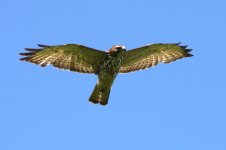carjug
Well-known member
I've been attending a local hawkwatch about three times a season for the last four years. Here are some lessons I may have learned.
1) It's hard. Seems easy, right? Fifteen species or so? Nope. They all look exactly alike.
2) Respect the leader. He or she is an experienced fanatic.
3) Good binoculars are key. Keep 'em clean.
4) Pack everything. Extra notebooks and pencils for when the leader takes off early, or Her car can't make it up the hill.
5) Learn the landmarks. Shouting out " bird over bumpy hill" is better than "over there".
6) It's fun.
Now if anyone,regardless of experience wants to add anything, feel free.
1) It's hard. Seems easy, right? Fifteen species or so? Nope. They all look exactly alike.
2) Respect the leader. He or she is an experienced fanatic.
3) Good binoculars are key. Keep 'em clean.
4) Pack everything. Extra notebooks and pencils for when the leader takes off early, or Her car can't make it up the hill.
5) Learn the landmarks. Shouting out " bird over bumpy hill" is better than "over there".
6) It's fun.
Now if anyone,regardless of experience wants to add anything, feel free.






